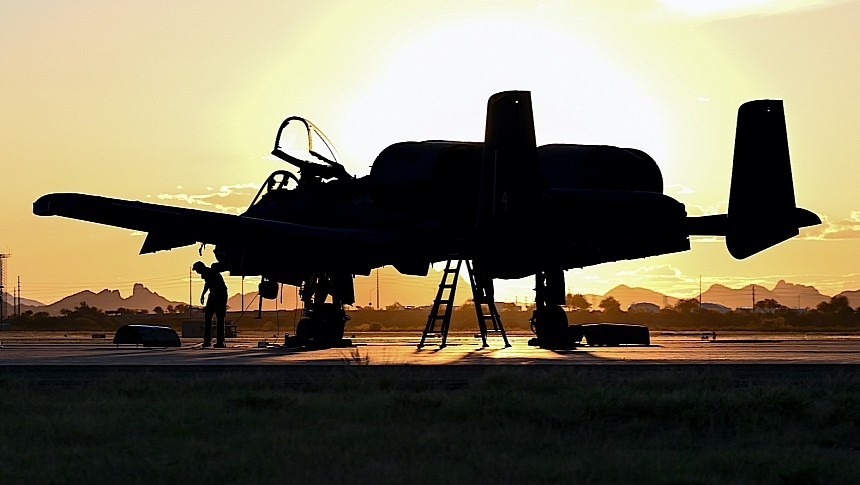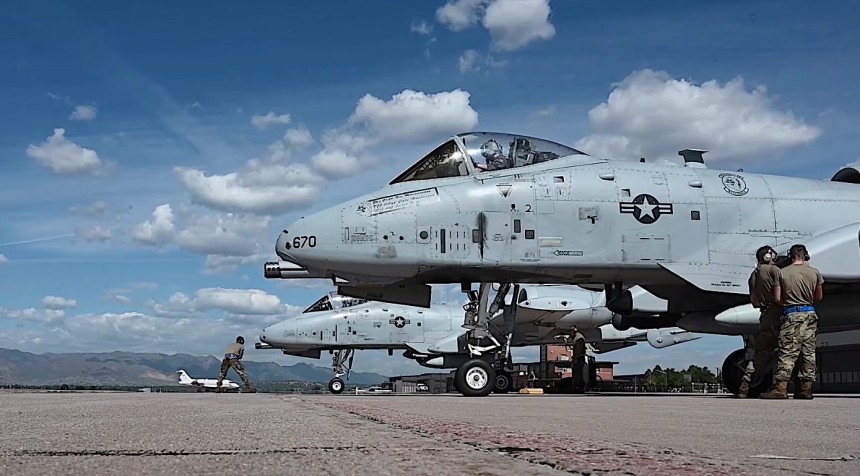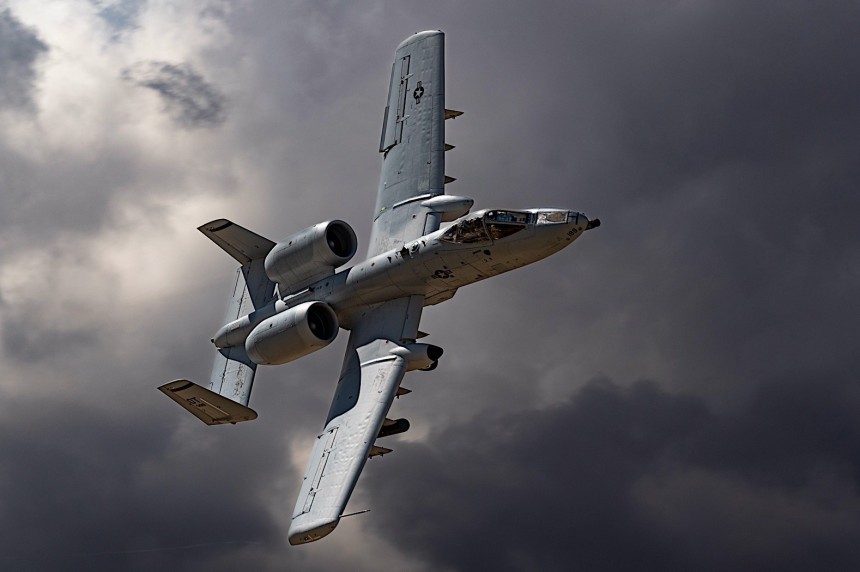I friggin love the A-10 Warthog. I've flown it in Ace Combat, War Thunder, and even the knockoff version in GTA Online. I've marveled at them in museums across multiple American states and even stood on the same grounds where the prototype YA-10s were designed and built in suburban New York. You probably won't find a bigger A-10 fanboy this side of a pro-NATO Reddit forum somewhere; you all know which ones. But even I have to make a confession.
I have to admit to myself and all of you that I think in a peer-to-peer World War-like conflict where both sides of the engagement are on equal footing, squadrons of A-10s would probably get their you-know-whats handed to them. For this reason, I say with a heavy heart that it's time to retire the A-10 Thunderbolt II from service. Not only that, but they should do it sooner rather than later. Believe it or not, this is a sentiment the U.S. Air Force is rapidly adopting itself.
Don't get me wrong; this isn't even close to some big-brain, super-insider hot take on my part. Plenty of people on the internet have said the same thing and did so in a considerably more entertaining fashion than I can come up with. I'll link the one I like the most down below. But to understand why the U.S. Air Force and the Pentagon might be ready to drastically change their never-say-die attitude towards the A-10, we need to go back to the program's genesis. Allow us to set the scene for you. It's the mid-1970s, and the USAF is grasping at straws in a desperate attempt to figure out the path forward for American close-air support aircraft.
Were fixed-wing aircraft fit for the job? The Air Force certainly didn't want another repeat of Vietnam, where hundreds of A-1 Skyraiders were lost, mostly from small-arms fire hurled at it. Or was a helicopter-based approach more apt? As Lockheed theorized with their AH-56 Cheyenne. Well, it should be apparent which side of the aisle the Pentagon staked their claim. In a Cold War that no one knew wasn't going to go hot, Pentagon personnel envisioned a future battlefield where squadrons of A-10s would flank vast columns of Soviet T-62s, T-64s, T-72s, and T-80s, with their accompaniment of support vehicles, mowing them down with its 30 mm GAU/8 Avenger autocannon *BRRRRRRRRT* machine.
Of course, this hypothetical apocalyptically destructive war never came to pass. Apart from the exception of the first Persian Gulf War, the A-10 found itself fighting in wars quite unlike the ones they were built to fight. Wars not packed to the gills with walls of armored divisions hurling shells at each other, but one of guerrilla warfare, insurgency, and a more visceral, personal style of warfare than anything Pentagon top brass could have theorized in the late 60s and early 70s. Ironically, it was a style of warfare not too dissimilar to the quagmire the U.S. was lucky to escape intact during Vietnam.
In the new-age crucible that was the War on Terror, the A-10 cemented its legacy as one of the most famous American warbirds built thanks to its portrayal in video games and films while having equally mixed results on real battlefields. Incidents of friendly fire, or blue-on-blue incidents, were a particularly jarring and unpleasant aspect of the A-10's service record during the War on Terror. This was regardless of how much morale was boosted when ground forces heard A-10s doing target practice overhead. A stark lack of a dedicated targeting pod during the early phases of the campaign meant determining friend from foe was with little more than a pair of binoculars considerably more difficult for Warthog pilots than it should have been.
At least four fatal blue-on-blue incidents have been recorded by the USAF and attributed to the actions of A-10 pilots during the conflict. The most notorious occurred on March 28th, 2003, when, during the Invasion of Iraq, a flight of two A-10s misidentified a lightly armored column from the British Blues and Royals Cavalry regiment as enemy combatants. In the ensuing chaos, two British Scimitar light tanks were destroyed, and lance-corporal of horse Matty Hull was killed and five of his comrades wounded. Admittedly, this was in contrast to over 40,000 combat sorties flown by A-10s during the same time frame.
Still, the incident became a black stain on an otherwise clean proverbial t-shirt. The entire fleet of operational A-10s wasn't fitted with targeting pods until much later in the campaign and at great expense to the U.S. taxpayers. Even during the previous Desert Storm campaign, regarded as the A-10's finest hour with hundreds of tanks felled by its hand, blue-on-blue incidents took place without the all-vital targeting pod. But with the main phase of the War on Terror now over, the A-10 might one day be fighting a larger conflict with the Russians, Chinese, or both, that's more in line with what Fairchild-Republic envisioned it would engage in back in the early 1970s. Except this time, conditions won't be nearly as favorable as you might think.
With modern high-powered ground radar, menacing anti-aircraft gun batteries, and hypersonic surface-to-air missiles that'd make high-altitude interceptors think twice before piercing enemy airspace, one can't help but think the A-10's rugged frame and titanium bathtub cockpit armor just won't cut in future conflicts the way it used to. Add in the fact that A-10 pilots like to fly low and slow over hostile battlefields in line with close-air support doctrine, and it doesn't take a grossly overpaid Pentagon bean counter to realize the former pride of American close-air support might soon become a tin can when thrown against the proverbial meatgrinder a World War III-level conflict could easily turn into.
Even without a hypothetical American-Chinese conflict in the near future, it was once thought that the current Russian Invasion of Ukraine would be a good match for the A-10's close-air support skill set against Russian armor. But with Ukrainian pilots already training on the F-16 Fighting Falcon over in the States and fresh shipments of American Abrams tanks already on Ukrainian soil, we find that the A-10 is starkly absent from Volodymyr Zelensky's list of NATO Christmas presents this holiday season. Despite what the A-10 enthusiast might think with those seemingly endless waves of Russian battalion tactical groups, it appears trusting a 50-year-old cannon with wings to take out Russian armor is a bridge too far for Ukraine.
With this in mind, is it any wonder that the USAF's Chief of Staff recently stated newly-minted plans to retire the whole A-10 fleet by 2029? With a commonly held belief that China wants to invade Taiwan by 2027 at the earliest, we wouldn't be surprised if said plans are expedited even further in the coming years. But to those who despair at the thought of A-10s not serving a role any more strenuous than gate guard duty, consider these words of comfort from the world's number one A-10 fanboy goober.
These days, I almost view the A-10 in the same regard as another iconic warbird designed on Long Island, the F-14 Tomcat. In the same way that Top Gun and countless portrayals in video games keep the Tomcat a culturally relevant airplane even 17 years after its retirement, the A-10 is a warbird that countless kids grew up flying virtually and admiring with reverence in adulthood. Nothing, no matter how many blue-on-blue incidents or questions about whether it's really effective as a tank buster, will ever, and I mean ever, take that reputation away.
But if you're still not convinced the A-10 should retire, I refer you to this two-part docuseries by the YouTuber LazerPig that details every reason that, in his mind, the A-10 "sucks." Although, if you ask me, it'd be more apt to say the A-10 was a solid, capable weapons platform built for a war that ultimately never happened and upgraded at a snail's pace. Rage about it all you want, but LP picks apart the A-10 in such a comical and entertaining way that I was standing on his side of the argument by the end of the series. Check the two videos out down below.
Don't get me wrong; this isn't even close to some big-brain, super-insider hot take on my part. Plenty of people on the internet have said the same thing and did so in a considerably more entertaining fashion than I can come up with. I'll link the one I like the most down below. But to understand why the U.S. Air Force and the Pentagon might be ready to drastically change their never-say-die attitude towards the A-10, we need to go back to the program's genesis. Allow us to set the scene for you. It's the mid-1970s, and the USAF is grasping at straws in a desperate attempt to figure out the path forward for American close-air support aircraft.
Were fixed-wing aircraft fit for the job? The Air Force certainly didn't want another repeat of Vietnam, where hundreds of A-1 Skyraiders were lost, mostly from small-arms fire hurled at it. Or was a helicopter-based approach more apt? As Lockheed theorized with their AH-56 Cheyenne. Well, it should be apparent which side of the aisle the Pentagon staked their claim. In a Cold War that no one knew wasn't going to go hot, Pentagon personnel envisioned a future battlefield where squadrons of A-10s would flank vast columns of Soviet T-62s, T-64s, T-72s, and T-80s, with their accompaniment of support vehicles, mowing them down with its 30 mm GAU/8 Avenger autocannon *BRRRRRRRRT* machine.
Of course, this hypothetical apocalyptically destructive war never came to pass. Apart from the exception of the first Persian Gulf War, the A-10 found itself fighting in wars quite unlike the ones they were built to fight. Wars not packed to the gills with walls of armored divisions hurling shells at each other, but one of guerrilla warfare, insurgency, and a more visceral, personal style of warfare than anything Pentagon top brass could have theorized in the late 60s and early 70s. Ironically, it was a style of warfare not too dissimilar to the quagmire the U.S. was lucky to escape intact during Vietnam.
At least four fatal blue-on-blue incidents have been recorded by the USAF and attributed to the actions of A-10 pilots during the conflict. The most notorious occurred on March 28th, 2003, when, during the Invasion of Iraq, a flight of two A-10s misidentified a lightly armored column from the British Blues and Royals Cavalry regiment as enemy combatants. In the ensuing chaos, two British Scimitar light tanks were destroyed, and lance-corporal of horse Matty Hull was killed and five of his comrades wounded. Admittedly, this was in contrast to over 40,000 combat sorties flown by A-10s during the same time frame.
Still, the incident became a black stain on an otherwise clean proverbial t-shirt. The entire fleet of operational A-10s wasn't fitted with targeting pods until much later in the campaign and at great expense to the U.S. taxpayers. Even during the previous Desert Storm campaign, regarded as the A-10's finest hour with hundreds of tanks felled by its hand, blue-on-blue incidents took place without the all-vital targeting pod. But with the main phase of the War on Terror now over, the A-10 might one day be fighting a larger conflict with the Russians, Chinese, or both, that's more in line with what Fairchild-Republic envisioned it would engage in back in the early 1970s. Except this time, conditions won't be nearly as favorable as you might think.
With modern high-powered ground radar, menacing anti-aircraft gun batteries, and hypersonic surface-to-air missiles that'd make high-altitude interceptors think twice before piercing enemy airspace, one can't help but think the A-10's rugged frame and titanium bathtub cockpit armor just won't cut in future conflicts the way it used to. Add in the fact that A-10 pilots like to fly low and slow over hostile battlefields in line with close-air support doctrine, and it doesn't take a grossly overpaid Pentagon bean counter to realize the former pride of American close-air support might soon become a tin can when thrown against the proverbial meatgrinder a World War III-level conflict could easily turn into.
With this in mind, is it any wonder that the USAF's Chief of Staff recently stated newly-minted plans to retire the whole A-10 fleet by 2029? With a commonly held belief that China wants to invade Taiwan by 2027 at the earliest, we wouldn't be surprised if said plans are expedited even further in the coming years. But to those who despair at the thought of A-10s not serving a role any more strenuous than gate guard duty, consider these words of comfort from the world's number one A-10 fanboy goober.
These days, I almost view the A-10 in the same regard as another iconic warbird designed on Long Island, the F-14 Tomcat. In the same way that Top Gun and countless portrayals in video games keep the Tomcat a culturally relevant airplane even 17 years after its retirement, the A-10 is a warbird that countless kids grew up flying virtually and admiring with reverence in adulthood. Nothing, no matter how many blue-on-blue incidents or questions about whether it's really effective as a tank buster, will ever, and I mean ever, take that reputation away.
But if you're still not convinced the A-10 should retire, I refer you to this two-part docuseries by the YouTuber LazerPig that details every reason that, in his mind, the A-10 "sucks." Although, if you ask me, it'd be more apt to say the A-10 was a solid, capable weapons platform built for a war that ultimately never happened and upgraded at a snail's pace. Rage about it all you want, but LP picks apart the A-10 in such a comical and entertaining way that I was standing on his side of the argument by the end of the series. Check the two videos out down below.


































